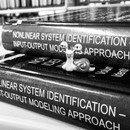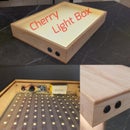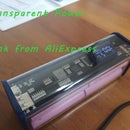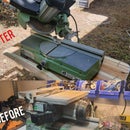Introduction: Portable Adjustable Lamp From Power Bank
Are you a DIYer like me?
Do you also like doing things everywhere in your home?
Like tweaking something precisely on that dark corner couch?
Or even just reading, wherever you feel like it?
So many convenient, cozy, perfect, and sometimes dark corners...
Not so great for your eyes, and you can't see a damn thing!
Want to solve this problem?
Read ahead - this portable lamp is exactly what you need!
Fully adjustable and light, and it is bright too!
This Instructable is designed around a DIY kit for a power bank. Uses several common and cheap components and requires basic skills.
The result is waay greater than the sum of the parts.
Hope you enjoy it,
Dani
Step 1: Gather Your Ingredients
The following are the things you will need. I always buy these in bulk because they are so useful and cheap, the links are provided accordingly:
- Power bank - this is the one I had and used in the instructable. This or this are more common, and probably be more convenient to use.
- I used a variation of UltraFire batteries. They work but not the best. Better quality batteries will serve you longer and have superior work time. Another option for better cells.
- Acrylic tube.
- Carbon tubes - I'm using 8mm*6mm tubes (8mm outer and 6mm internal diameters). Here are two good options: first, second.
- LED strips - you probably have some leftovers from previous projects. If not here are several options to get them: one, two, three. You can even go crazy and add various colors to the mix.
- 1s lithium charging and protection pcb - here or here. This is probably the most useful thingy I've come across in the last years, makes lithium batteries useful and fun.
- Voltage booster - here or here. Another useful electronic piece, adjusts voltage for low power consumption devices.
- Switch - simple on/off micro switch - option one and two.
- Heat shrink sleeves - I always recommend this set. I've got it years ago and it still has plenty of pieces left.
You will need basic tools like soldering iron, drill, hot glue gun and access to 3d printer
Also, stuff that you probably already have: some wire, 8-32 bolts, epoxy, super glue.
Step 2: Print the Small Parts
There are several things that should be printed, small bits and pieces.
All of them are at Thing 2909365.
Please print one of each piece, except the "block" - 3 pieces required.
Step 3: Mount the Base Piece
The pieces are designed around 8-32 bolts and nuts.
Later, you will require two smaller bolts to attach the acrylic tube, but more on this later.
- Position the base unit where you want it to go on the power bank.
- Mark the bolts locations.
- Drill.
- Attach the base
Note the central bolt goes from the opposite side, this will serve as a hinge for the carbon arms (see pictures).
Step 4: Cut the Acrylic/Adjust and Cut the Carbon Tubes
I wanted this lamp to be as compact as possible, while still be adjustable and convenient.
The first step is to take your acrylic tube and cut it in half.
Sand the edges so the two pieces will be the exact length - this will ensure clean interface.
Now let's cut the carbon tubes:
- Super glue one of the blocks to the end of the tube and drill the hole for 8-32 bolt.
- Depending on the power bank you have, cut the length so it won't stick out past the box.
- Glue the second block, drill the hole.
- Glue the third block to the second tube and drill the hole.
- Now you should have two hinged block sections.
- Decide on how much will the second tube stick out and cut accordingly.
- Make sure the bottom doubler will not interfere with the box while in folded position.
- Add the wheels with nuts.
We are finished with the mechanics!
Step 5: Wire the Lights
One more thing before we proceed;
Take a fine grit sandpaper and sand the acrylic tubes from the outside. This will give a nice texture and better light dissipation.
Now we are going to assemble the lights:
- Test fit the acrylic tubes and the 3d printed doubler parts.
- Bolt the carbon tube to the bottom doubler using two M3 bolts (or similar, the exact size matters less).
- Take a piece of paper and roll two cylinders that will fit inside the acrylic tubes.
- Take your LED strip and wrap it around these two paper cylinders.
- Now, there is a channel for wires in the upper doubler part. This one connects the two cylinders.
- Solder the two cylinders through these two wires.
- Additional pair of wires come through the base carbon tube into the acrylic cylinder, solder this to the LED strip.
It is a good practice to check the functionality at each of the steps. I do this a lot to make sure everything is still working.
We are finished with the lights!
Step 6: Wires Routing
This is probably the most tedious part, but not very bad actually.
The wires from the acrylic tubes need to go down the carbon tubes and into the box.
Allow some slack between the sections for future movement.
I added a heat shrink sleeve there to protect the wires, works really good.
Not much more to it. Just carefully route them through everything.
Step 7: Assemble the Electrical Part
This is where we adapt the available power bank box for our purposes.
In my case the box was designed for 6 18650 cells. We are going to use only 4 of them, because we need the additional space.
So, first, assemble the 4 batteries in parallel and wire them to the existing circuit in the power bank.
This circuit will allow you to charge the cells and use the whole thing as a good old power bank for your phone or whatever you like.
Next, from the other side wire the batteries to 1s lithium charger pcb. This little unit functions also as a protection board from over discharging.
Why would you do that? Doesn't the original circuit in the box already has this feature?
Yes it does!
But now we are going to drain the cells through the "other side" - the LED strips, so the cells will need the additional protection.
The batteries go to -/+B pads on the pcb.
The -/+out pads go to the voltage booster -/+in pads. Take one of these wires and route it through the on/off switch.
The -/+out pads from the voltage booster connect to the LED wires.
Adjust your voltage booster to ~12v and secure everything with hot glue.
Step 8: Before You Close...
This part was tricky because of the particular type of power bank I had.
Mine closed in a "slide on" motion.
Before this can be performed, adequate slack had to be insured. Not forgetting the shrink wrap on the wires and the switch.
You can see on the pictures the condition everything was prior to the last sliding motion.
Make sure there is room for everything.
Everything is connected electrically and functioning.
Enough slack for the final assembly to move and function.
Then, slide in to close.
Step 9: Enjoy Your New and Useful Portable Lamp
The outcome is pretty cool.
My wife simply loves it, thus I rarely enjoy it now :)
But you can!
Enjoy,
Dani













